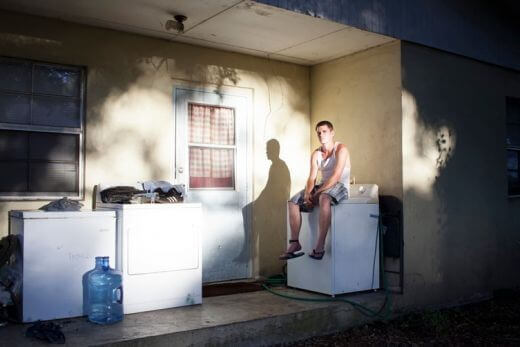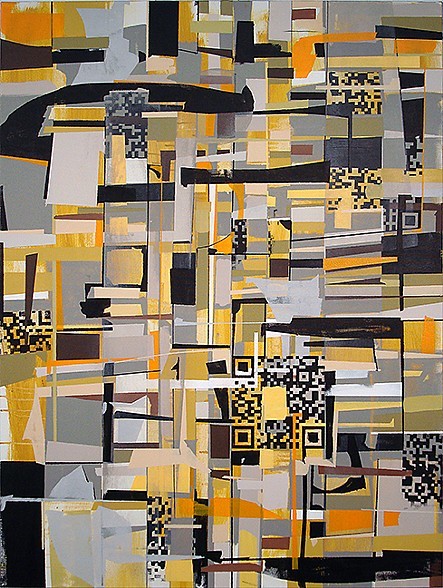Evoking the Forms at MOCA North Miami
Daniel A. Siedell

Sofia Valiente, Doug, 2013
—Cormac McCarthy, The Road
This phrase came to mind as I walked through Alternative Contemporaneity: Temporary Autonomous Zones at the Museum of Contemporary Art, North Miami, and it has remained with me as I continue to think about the show’s implications. Alternative Contemporaneity is an eclectic and wide-ranging invitational exhibition that has the feel of the apocalyptic about it and the sense that the works included appear in an abandoned—and haunted—battlefield.
And indeed they have. Last year, prompted by a proposed merger with the Bass Museum of Art, the museum’s board of trustees and the city of North Miami engaged in a drawn-out dispute that ultimately resulted in the division of the museum’s collection between the city and the former board. The latter decamped to the Design District where they have founded the Institute of Contemporary Art, Miami, in an effort to keep the city on the map as a destination for the international art-world elites. Underneath the surface of art museums’ public programming—the exhibitions, lectures, and publications—boils a cauldron of cultural politics. For the stakeholders, the battles are violent, and the casualties real. And this is all the more vicious because it takes place covertly, hidden under the banner of public trust and civic responsibility for bringing culture to the community. Whether it’s Joseph Goebbels, who reached for his revolver when he heard the word or Groucho Marx who reached for his wallet, “culture” is not for the faint of heart. And it is also not necessarily for the community.
Alternative Contemporaneity is a courageous attempt by director Babacar M’Bow, artist/curator Richard Haden, and educator Dr. Adrienne von Lattes to reclaim contemporary art from what M’Bow calls in his catalogue essay the “tiny, economic elite” who consider it (or its possession) solely as currency in the churning global market. For the MOCA team, contemporary art has the potential to explore what it means to be human amid the economic, social, and political systems that dehumanize. This is why, despite its apocalyptic appearance, it is a fundamentally hopeful exhibition.
Alternative Contemporaneity retheorizes contemporary art (and MOCA’s role as a presenting institution) through the conceptual frameworks of “contemporaneity” and “Temporary Autonomous Zones,” both of which offer a way to protect and develop a contemporary artistic (and critical) practice that is self-consciously aware of these dehumanizing systems of power and art’s complicity within them.

Kyle Trowbridge, This will stay with you until you die!, 2015. Acrylic on canvas, 121.9 x 91.4 cm.
Over the last decade, a few art historians and critics have sought to interrogate the empty and problematic category “contemporary art” and the presumption in the art world that, as Terry Smith observes, “one cannot—indeed should not—have any idea about it.”1 This has, according to Smith, produced an “upbeat mindlessness that has come to pass for art discourse” that is a symptom of globalization and neoliberal economies that produce dramatic inequalities, that are mediated by image-saturated cultures. This “upbeat mindlessness” about the nature of contemporary art that allows markets to define it is exemplified by the opinion of Sotheby’s former auctioneer Tobias Meyer, that “the best art is the most expensive because the art market is so smart.”
“Contemporaneity” has become a useful category through which Smith and others have sought to return historical, conceptual, and critical judgment and analysis to an art world system that has increasingly become not merely “mindless,” but inhuman. It is also a means of creating a space in the art world that is not defined by The Artworld. Smith argues, “For the history of contemporary art the core subject of inquiry is the art, the ideas, the cultural practices and the values that are created within the condition of contemporaneity.”2
Exploring this condition thus becomes a means to recover a more concrete, embodied, relational aspect of human action, including artistic practice, both locally and globally. It is a means by which the human being, through artistic practice and the experience of art, can break out of the hermetically sealed isolation and eternal return of the “contemporary” into a porous present that is open both to the distinctive pasts and the futures of individuals and communities.
I found this porosity of the present moment in Jeroen Eisinga’s hauntingly beautiful video Springtime (2010–11), in which the artist is covered with 150,000 bees. Kyle Trowbridge’s painting, This will stay with you until you die (2014), addresses the capacity of a painting to address the viewer in multiple ways, to “look one way and behave another,” as Trowbridge observes. And Agustina Woodgate’s playful installation of fifty white spheres, The Ballroom (2014), spills out onto the exhibition floor and invites the viewer to engage with and even move the spheres at will. James Concannon’s Basing Street and Lancaster Road (2014), which features two “re-written historical odes” to British romantic poet William Blake and the English radical group King Mob (c. late 1960s), exemplifies a “contemporaneity” that exists through time.
Temporary Autonomous Zones
Rather than accept its “far-flung” geographical location in North Miami as a limitation, museum leaders have transformed it into an “archipelago,” an island of resistance, for both cultural critique and creative practice. They call this island a Temporary Autonomous Zone, or TAZ.
It is a term coined by Hakim Bey (aka Peter Lamborn Wilson), a self-described “sufi-anarchist,” who observed the emergence of these informal, yet unusually potent communities throughout his historical research as a recurring strategy of resistance to coercive and dehumanizing social, cultural, and political frameworks and forces.3 For Bey, a TAZ is an improvised community that can—for a time—preserve the integrity of authentic personal human freedom through the cultivation of creativity, spontaneity, autonomy, and imagination. “The works assembled in this exhibition,” Haden writes in his curatorial statement, “speak collectively as zones of authenticity.”4
Works that seem to create, or perhaps rely on the presence of these zones are, for example, Sofia Valiente’s humane and sensitive photograph, Doug (2013), which depicts one of the one hundred convicted sex offenders that live in a small community called Miracle Village near Lake Okeechobee. Misael Soto’s conversations and encounters explore “shared experiences and participatory situations” while Gavin Perry’s simple yet spatially suggestive rebar and epoxy resin circular forms encourage the viewer to experience shifting spatial relationships, enacted by an artifact that refuses to demand attention as precious.
Dangers
The two-pronged theoretical framework for Alternative Contemporaneity, which I find provocative and promising, invites two significant dangers.
The first is to identity “contemporary art” too closely with the collectors who convene in Miami Beach, Basel, and Kassel for the art fairs, New York for the auctions, and who subscribe to ArtFacts.net. Or, put another way, confuse official Contemporary Art with contemporary art practices and institutions. For example, despite the fact that Edvard Munch’s The Scream was purchased at auction in 2012 for $129 million, this does not, or should not, cause us to forget what Munch said about his desire to paint “his soul’s dairy” as an attempt to find the truth about himself and the world, and, just as importantly, his hope that his paintings would help viewers—then as well as today—on their own personal search for truth. Needless to say, few collectors, dealers, and curators approach works of art with that much existential and emotional skin in the game. Perhaps the concept of “contemporaneity” can be a means to recover the integrity and dignity of finding meaning in the world through works of art, no matter when they were made.
The second danger is to over-theorize. M’Bow’s catalogue essay is an ambitious, utopian call to transform art and culture locally and globally, consisting of nothing less than “re-imagination of representation through a new order of knowledge.”5 But the heavy use of theoretical abstractions and academic jargon can tend to be just as alienating to the community as the blue-chip art collectors. The temptation to over-theorize, against which I struggle constantly, can drain the aesthetic potency of art to challenge and nourish the emotional, intellectual, and imaginative life of the person who stands in front of it. Or, perhaps more problematically, it fails to compel readers to go to art, to live with it and allow it to live with them. Too often neither the collectors nor the theoreticians trust art’s capacity to address the dignity of the human being who encounters it, a capacity that can empower the individual spontaneously, freely, and authentically.
Bey is helpful here. In his foreword to the exhibition catalogue he reminds us, “the simplest form of the TAZ would be a love affair, or a dinner party with friends, where no one enforces rules & the goal is mutual enhancement of pleasure.”6 Neither theory nor commodification has any place in such embodied, spontaneous, aesthetic experiences—and no, discourse about Barthes’s notion of “jouissance” is not the same as experiencing it un-self-consciously and nontheoretically with another. And it seems to me that this is the register at which artistic practices operate: the love affair, the dinner party, a search for personal truth that opens one up to others without cynicism, irony, and abstractions—too often the standard fair for theoreticians. The challenge is to mobilize theoretical thinking in the service of a “relational aesthetics” that preserves and cultivates, through particular aesthetic experiences, our capacity to flourish, individually and in communities.
Evoking the Forms
“I don’t believe anyone can simply decree a TAZ,” Bey concludes in his letter to the organizers of Alternative Contemporaneity, “but I do believe that we can act in such a way as to evoke them. This form of action (or “art”) has certain things in common with magic—that is, with will & desire.”7 Left with nothing in the aftermath, McCarthy’s man and boy use what they have to evoke the forms, to offer a ritual—an artistic performance—that in its simple beauty and human dignity, is an aesthetic embodiment, if only momentarily, of both “contemporaneity” and a “Temporary Autonomous Zone.”
May those involved in MOCA North Miami have the “will & desire” to “evoke the forms” in future exhibitions, to work toward preserving this Temporary Autonomous Zone and perhaps transform it into one that might become more permanent.
DANIEL A. SIEDELL, Ph.D., teaches art history at The King’s College in New York and theology at Knox Theological Seminary in Fort Lauderdale.
1 Terry Smith, “Questionnaire on the Contemporary,” October 130 (Fall 2009): 46.
2 Terry Smith, What is Contemporary Art? (Chicago: University of Chicago Press, 2009), 256.
3 Hakim Bey, T.A.Z.: The Temporary Autonomous Zone: Ontological Anarchy and Poetic Terrorism (Brooklyn: Autonomedia, 1991).
4 Richard Haden, “TAZ Tactical,” in Alternative Contemporaneity: Temporary Autonomous Zones (MOCA North Miami, 2015), 9.
5 Babacar M’Bow, “From Temporary to Permanent Autonomous Zones: Towards a Dialectical Contemporary,” in ibid., 5.
6 Foreword to ibid., 3.
7 Ibid.










